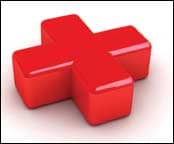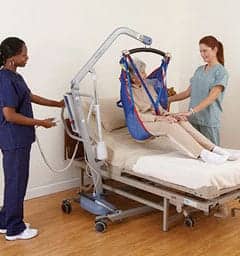Assessing goals and strategic direction during capital equipment purchases helps equip therapists with the tools they need to ensure optimized patient outcomes
by Ralph Garlitos, PT, and Sheila Boyd, OT

The selection for rehab equipment, it seems, continues to grow larger while the available budget grows smaller.
In today’s health care industry, maximizing efficiency and minimizing cost is a “must” for survival. Diminished capital dollars force us to request items that will provide our hospital with the best patient outcomes while remaining a low-cost provider.
It is imperative that a strategy be in place for requisition of capital equipment. How do we prioritize what we need? John Evanoo and Debbie Cameron wrote an article for Healthcare Financial Management Association (2010) about developing sound Capital Equipment Strategic Planning (CESP). The technology assessment should provide a snapshot of the efficacy of each clinical device by formulating data from maintenance history, risk associated with ongoing/extended use, remaining device support and serviceability, level of technology sophistication, clinical utilization and impact, and industry benchmark data.1
At CHRISTUS St. Michael Rehabilitation Hospital, we employ a similar approach for justification of requested capital items (for our hospital, capital expenses are items that cost $5,000 or greater). As a faith-based, not-for-profit organization, we align our organizational processes—including requests for capital expenses—with our hospital mission statement and organizational direction. Having a firm understanding of the organization’s goals and strategic direction leverages the need for future capital requisition.
Our requests for capital equipment go through several phases for final approval. Prior to presenting it to our capital committee, we survey our associates for their suggestions through casual conversations, at department meetings, or during performance evaluations. Involving associates in the decision-making process empowers them to be creative and explore innovative ideas. An additional benefit of this process is fostering “ownership” of the organization’s assets. Any equipment that does not qualify for capital request has to go through Materials Management. We work closely with the Materials Management Department for discounted pricing and preferred vendors to keep costs down.
All that Glitters Is Not Gold
There are too many products to choose from, and all seem to make claims about great outcomes. We realize cutting-edge technology today may be obsolete tomorrow. As much as we want the new gadgets, we have to evaluate concrete evidence of proven results. Implementing evidence-based practices into treatment facilitates needed results in a shorter amount of time.
We pursue information contained in professional journals and webinars to ensure that the equipment under consideration supports effective and efficient treatment. Creativity is the mother of all inventions. Generally, rehabilitation professionals are creative individuals so we take advantage of that! Prior to equipment consideration, we look at high-tech versus low-tech equipment. Can outcomes be replicated without purchasing costly products? Is the device the patient is currently using in rehab temporary or permanent? Does the device allow for modification or upgrade as the patient improves or declines? We utilize ace wraps, rubber bands, PVC pipes, weight lifting gloves, duct tape, floatation devices, grocery carts, and other common household items. We sometimes have to custom build the equipment or ask the assistance of our plant operations department. The intent is to augment their treatments using low technology in conjunction with high technology-based products.
CHRISTUS St. Michael Rehabilitation Hospital has implemented several capital items to improve quality of care. Among adults aged 65 or older, 36% to 40% fall at least once a year.2,3 Falls are the leading cause of unintentional injuries and injury deaths among this population. We built our comprehensive fall reduction program from the floor up, implementing cell flooring in two patient rooms and utilizing those rooms for “high risk” patients. The purpose of this flooring is to protect the patient during their highest risk for fall, in the area they are most likely to fall. Prolonged hospitalization, recent surgery, pain medication, unfamiliar environment, and lack of knowledge regarding adaptive equipment increase the patient’s risk of fall. Since implementing this flooring in 2010, we have had no major injuries related to falls in these rooms.
Patient Lifts
Safe Patient Handling education was implemented following the Texas Safe Patient Handling Law (TX SB 1525), which took effect January 1, 2006. This class emphasizes protection of the patient and the health care worker. Clinical associates learn benefits of early mobility and review in detail our fall program using a transdisciplinary approach. The Safe Patient Handling Class also instructs our associates on monitoring devices such as wheelchair alarms, bed alarms, and closed-circuit monitors. Clinicians receive training on the use of lifts, learn safety precautions related to patient lifts, and practice lifting skills.
Partial Body Weight Support System
Our rehabilitation facility has purchased a body weight support system that can be used for over-ground or treadmill ambulation. The versatility has allowed our clinicians to walk patients on the treadmill, around the therapy gym, in the hallway, and to their rooms. It may or may not eliminate the need for “extra hands” for assistance but allows the therapist to facilitate normal standing while the patient is attending to other tasks or during ambulation.
Virtual Reality Game System
Virtual reality modalities have become an additional and possibly an integral part of a patient’s rehabilitation process. For our facility a system with software and a balance board attachment often marketed to consumers was chosen, based on our therapists’ requests. This system is cost-effective and readily available for patients to purchase for continued home use. It also has proven to be effective in vestibular rehabilitation in elderly patients.4 It may also be an alternative modality to improve patient participation, particularly if the activity selected is engaging to the patient.5
Lower Extremity Electrical ?Stimulation Neuro-prosthesis
Several electrical stimulation units work specifically on improving dorsiflexion of the ankle during ambulation and are available in the market. We have asked our clinicians, researched articles, surveyed other rehab facilities for their preferences, and viewed vendor demonstrations. In the end, our hospital’s preference was a device that offered the ability to walk on different surfaces. We continue to use the electric stimulation neuro-prosthesis with patients during different phases of their rehabilitation, including inpatient rehab, day rehab, and outpatient rehab, with success.
Mobility Courtyard
Construction of an outdoor mobility courtyard allows our patients to practice outdoor functional activities on various surfaces while completing community tasks. Various activities are available and can be simulated for patients to check the mail, ambulate up a ramp or different stair levels, fill the fireplace with wood, feed the birds, or garden in the raised planter. The courtyard offers multisurfaces including grass, sand, dirt, gravel, etc. Having an outdoor mobility courtyard in Texas allows for an outdoor experience 9 months out of the year. The courtyard has been used for other purposes aside from its physical therapeutic benefits. Patients and their families have been observed using it for small gatherings, celebrating a loved one’s birthday, or just spending a quiet moment with friends.
Other Items
A recumbent stepper, treadmill, wheelchairs of varying widths and sizes with interchangeable parts, bariatric parallel bars, and bariatric hydraulic standing frame are examples of requested equipment. Considerations for the requests were based on our need to augment current training practices for reciprocal movement with limited standing tolerance in preparation for ambulation, meet the needs of the bariatric population, and replace aging equipment.
Clinical software can also periodically be considered for capital expenditures. The priority for software expenditures varies, but when we evaluate our need for software, the product aspects we focus on for value include scalability, interface options, ability to improve efficiencies, and support for clinical decision making.
Plans for the Future
Future plans are to construct grocery bins and shelves inside our rehab gym. These additions will incorporate purposeful walking and functional reach for higher-level gait activities with multi-tasking similar to grocery shopping. Cognitive retraining including problem solving, sequencing, and social interaction may be included in this activity. Another item under consideration is an additional motorized hi-lo mat for patients needing varying surface heights. Our rehabilitation gym currently has a “half mid-sized car” for patients to practice car transfers indoors. In this region, northeast Texas, the majority of patients own an SUV or a full-sized truck. To meet their needs, we have considered adding a “half pick-up” truck acquired through a donation from a local automotive shop or community college. One of the more expensive items on our wish list is the acquisition of a ceiling track and lift system or an over-ground body weight support system.
Our rehabilitation hospital does not choose the most expensive, state-of-the-art equipment to keep up with current trends in inpatient rehabilitation. We attempt to balance the procurement of certain types of equipment with the continuing education needs of our rehab professionals. In the past, health care employers have provided employees with individual education budgets earmarked for training. As this may not be feasible today or in the future, the authors have spent considerable amounts of time researching untapped avenues to fund educational training. Education grants have been written to fund continuing education. Rather than send individual therapists for outside education, speakers were brought to the facility to conduct live seminars and workshops. The entire rehab team is tasked with implementing the new knowledge to our specific patient population’s needs.
We strive to equip our therapists with the tools they need to be successful in delivering care to their patients. We also emphasize training our therapists to prepare them on what they may encounter when faced with limited resources for equipment. After all, tools are only as good as the skills of the therapist. RM
Ralph Garlitos, PT, has been the Physical Therapy Manager for CHRISTUS St. Michael Rehabilitation Hospital and CHRISTUS Dubuis Hospital of Texarkana, Tex, for 7 years. He has been a therapist for 22 years and in a management role for 15 years. Sheila Boyd, OT, serves as the Occupational Therapy Manager for CHRISTUS St. Michael Rehabilitation Hospital and CHRISTUS Dubuis Hospital of Texarkana. She is an Assistive Technology Practitioner focusing on power mobility devices. She has been a therapist for 16 years and in a management role for 7 years. For more information contact [email protected].
References
1. Evanoo J, Cameron D. The Case to Replace: Developing a Sound Capital Equipment Strategy. Healthcare Financial Management Association. February 2010. Available at: http://www.hfma.org/templates/print.aspx?id=4840. Accessed November 5, 2012.
2. Falls among older adults: an overview. Centers for Disease Control and Prevention; 2007. http://www.cdc.gov/HomeandRecreationalSafety/Falls/adultfalls.html Accessed January 20, 2012.
3. Gillespie LD, Robertson MC, Gillespie WJ, Lamb SE, Gates S, Cumming RG, et al. Interventions for preventing falls in older people living in the community. Cochrane Database System Rev 2009;(2):CD007146.
4. Sparrer, Duong Dinh TA, Ilgner J, Westhofen. Vestibular rehabilitation using the Nintendo® Wii Balance Board-user friendly alternative for central nervous compensation; Acta: Otolaryngolica Nov 6, 2012. Available at: http://ncbi.nlm.nih.gov/pubmed/23131174. Accessed November 26, 2012.
5. Fung V, So K. Park E, Ho A, Shaffer J, Chan E, Gomez M. The utility of a video game system in rehabilitation of burn and non-burn patients: a survey among occupational and physiotherapy practitioners. Journal of Burn Care and Research.2010 Sept-Oct 31; 31(5):768-75.





